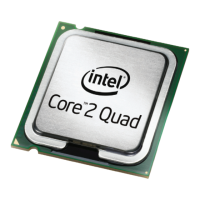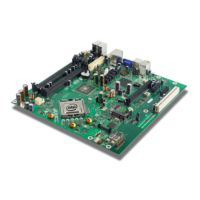Thermal Management Logic and Thermal Monitor Feature
Thermal and Mechanical Design Guidelines 37
4.2.10 Digital Thermal Sensor
The processor utilizes the Digital Thermal Sensor (DTS) as the on-die sensor to use
for fan speed control (FSC). The DTS replaces the on-die thermal diode used in
previous product. The DTS is monitoring the same sensor that activates the TCC
(See Section
4.2.2). Readings from the DTS are relative to the activation of the TCC.
The DTS value where TCC activation occurs is 0 (zero).
The DTS can be accessed by two methods. The first is via a MSR. The value read via
the MSR is an unsigned number of degrees C away from TCC activation. The second
method which is expected to be the primary method for FSC is via the PECI interface.
The value of the DTS when read via the PECI interface is always negative and again is
degrees C away from TCC activation.
A T
CONTROL
value will be provided for use with DTS. The usage model for T
CONTROL
with
the DTS is the same as with the on-die thermal diode:
•
If the Digital Thermometer is less than T
CONTROL,
the fan speed can be reduced.
• If the Digital Thermometer is greater than or equal to T
CONTROL,
then T
C
must be
maintained at or below the Thermal Profile for the measured power dissipation.
The calculation of T
CONTROL
is slightly different from previous product. There is no base
value to sum with the T
OFFSET
located in the same MSR as used in previous processors.
The BIOS only needs to read the T
OFFSET
MSR and provide this value to the fan speed
control device.
Figure 10. T
CONTROL
for Digital Thermometer
Multiple digital thermal sensors can be implemented within the package without
adding a pair of signal pins per sensor as required with the thermal diode. The digital
thermal sensor is easier to place in thermally sensitive locations of the processor than
the thermal diode. This is achieved due to a smaller foot print and decreased
sensitivity to noise. Since the DTS is factory set on a per-part basis there is no need
for the health monitor components to be updated at each processor family.

